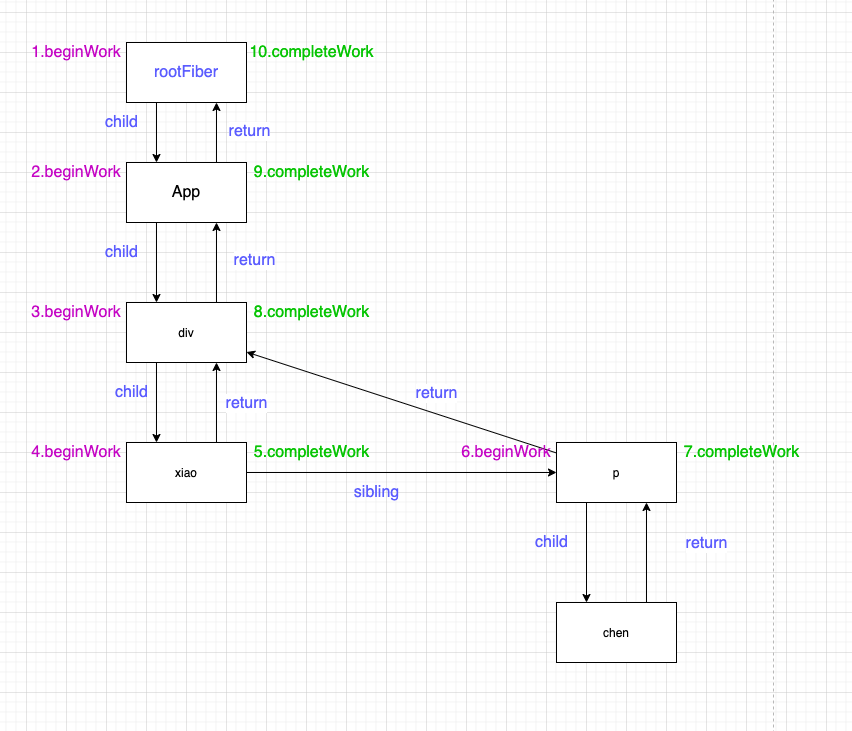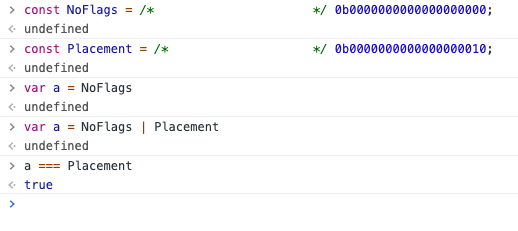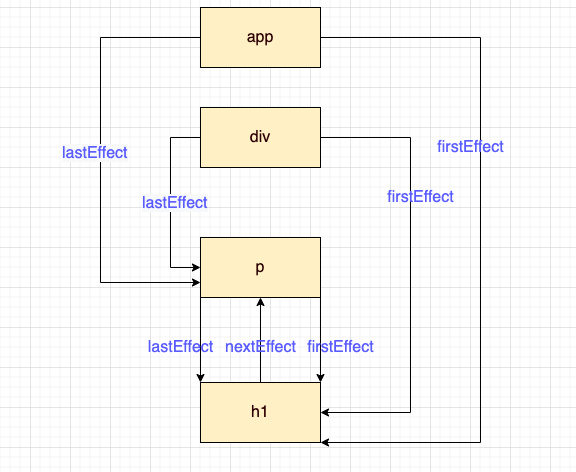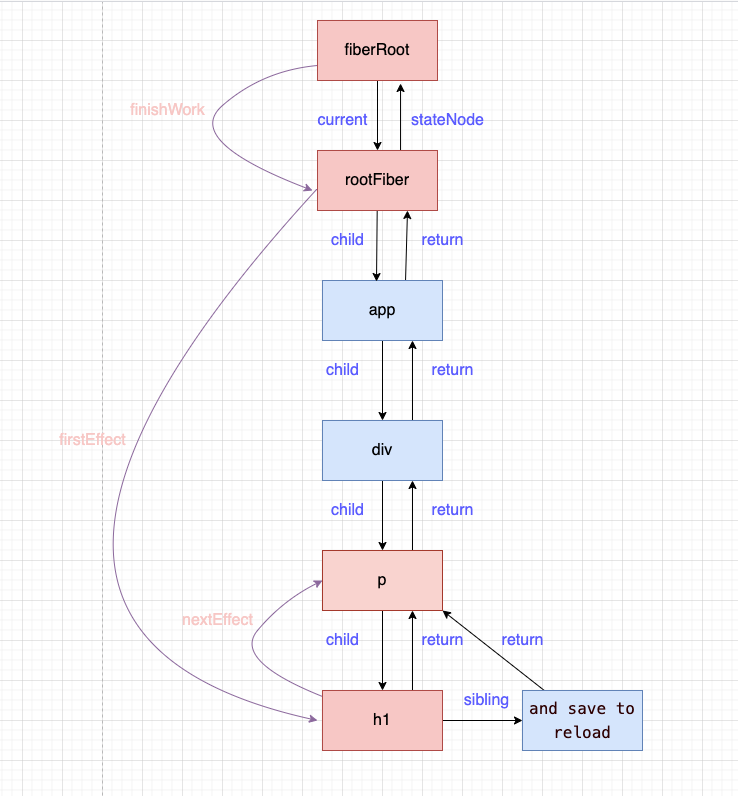render 阶段 render阶段的主要工作是构建Fiber树和生成effectList,在第5章中我们知道了react入口的两种模式会进入performSyncWorkOnRoot或者performConcurrentWorkOnRoot,而这两个方法分别会调用workLoopSync或者workLoopConcurrent
1 2 3 4 5 6 7 8 9 10 11 function workLoopSync ( while (workInProgress !== null ) { performUnitOfWork(workInProgress); } } function workLoopConcurrent ( while (workInProgress !== null && !shouldYield()) { performUnitOfWork(workInProgress); } }
这两函数的区别是判断条件是否存在shouldYield的执行,如果浏览器没有足够的时间,那么会终止while循环,也不会执行后面的performUnitOfWork函数,自然也不会执行后面的render阶段和commit阶段,这部分属于scheduler的知识点,我们在第12章讲解。
workInProgress:新创建的workInProgress fiber
performUnitOfWork:workInProgress fiber和会和已经创建的Fiber连接起来形成Fiber树。这个过程类似深度优先遍历,我们暂且称它们为‘捕获阶段’和‘冒泡阶段’。执行的过程大概如下
1 2 3 4 5 6 7 8 9 function performUnitOfWork (fiber ) if (fiber.child) { performUnitOfWork(fiber.child); } if (fiber.sibling) { performUnitOfWork(fiber.sibling); } }
render阶段整体执行流程 看断点调试视频,函数执行细节更清楚详细:
从根节点rootFiber开始,遍历到叶子节点,每次遍历到的节点都会执行beginWork,并且传入当前Fiber节点,然后创建或复用它的子Fiber节点,并赋值给workInProgress.child。
在捕获阶段遍历到子节点之后,会执行completeWork方法,执行完成之后会判断此节点的兄弟节点存不存在,如果存在就会为兄弟节点执行completeWork,当全部兄弟节点执行完之后,会向上‘冒泡’到父节点执行completeWork,直到rootFiber。
示例
1 2 3 4 5 6 7 8 9 function App ( return ( <div> xiao <p>chen</p> </div> ) } ReactDOM.render(<App /> document .getElementById("root" ));
当执行完深度优先遍历之后形成的Fiber树
图中的数字是遍历过程中的顺序,可以看到,遍历的过程中会从应用的根节点rootFiber开始,依次执行beginWork和completeWork,最后形成一颗Fiber树,每个节点以child和return相连。
注意:当遍历到只有一个子节点的Fiber时,该Fiber节点的子节点不会执行beginWork和completeWork,如图中的chen文本节点。这是react的一种优化手段
beginWork beginWork主要的工作是创建或复用子fiber节点
1 2 3 4 5 6 7 8 9 10 11 12 13 14 15 16 17 18 19 20 21 22 23 24 25 26 27 28 29 30 31 32 33 34 35 36 37 38 39 40 41 42 43 44 45 46 47 48 49 50 51 52 53 function beginWork ( current: Fiber | null , workInProgress: Fiber, renderLanes: Lanes, Fiber | null if (current !== null ) { const oldProps = current.memoizedProps; const newProps = workInProgress.pendingProps; if ( oldProps !== newProps || hasLegacyContextChanged() || (__DEV__ ? workInProgress.type !== current.type : false ) ) { didReceiveUpdate = true ; } else if (!includesSomeLane(renderLanes, updateLanes)) { didReceiveUpdate = false ; switch (workInProgress.tag) { } return bailoutOnAlreadyFinishedWork( current, workInProgress, renderLanes, ); } else { didReceiveUpdate = false ; } } else { didReceiveUpdate = false ; } switch (workInProgress.tag) { case IndeterminateComponent: case LazyComponent: case FunctionComponent: case ClassComponent: case HostRoot: case HostComponent: return updateHostComponent(current, workInProgress, renderLanes) case HostText: } }
从代码中可以看到参数中有current Fiber,也就是当前真实dom对应的Fiber树,在之前介绍Fiber双缓存机制中,我们知道在首次渲染时除了rootFiber外,current 等于 null,因为首次渲染dom还没构建出来,在update时current不等于 null,因为update时dom树已经存在了,所以beginWork函数中用current === null来判断是mount还是update进入不同的逻辑
1 2 3 4 5 6 function updateHostComponent (current, workInProgress, renderLanes ) var isDirectTextChild = shouldTextContent(type, nextProps) reconcileChildren(current, workInProgress, nextChildren, renderLanes) return workInProgress.child }
1 2 3 4 5 6 7 function reconcileChildren (current, workInProgress, nextChildren, renderLanes ) if (current === null ) { workInProgress.child = mountChildFibers(workInProgress, null , nextChildren, renderLanes) } else { workInProgress.child = reconcileChildren(current, workInProgress, nextChildren, renderLanes) } }
创建子fiber的过程会进入reconcileChildren,该函数的作用是为workInProgress fiber节点生成它的child fiber即 workInProgress.child。然后继续深度优先遍历它的子节点执行相同的操作。
reconcileChildren会区分mount和update两种情况,进入reconcileChildFibers或mountChildFibers,reconcileChildFibers和mountChildFibers最终其实就是ChildReconciler传递不同的参数返回的函数,这个参数用来表示是否追踪副作用,在ChildReconciler中用shouldTrackSideEffects来判断是否为对应的节点打上effectTag,例如如果一个节点需要进行插入操作,需要满足两个条件:
fiber.stateNode!==null 即fiber存在真实dom,真实dom保存在stateNode上
(fiber.effectTag & Placement) !== 0 fiber存在Placement的effectTag
1 2 export const reconcileChildFibers = ChildReconciler(true )export const mountChildFibers = ChildReconciler(false )
1 2 3 4 5 6 7 8 9 10 11 12 13 14 15 16 17 18 19 20 21 22 23 24 25 26 27 28 29 30 function ChildReconciler (shouldTrackSideEffects ) function placeChild (newFiber, lastPlacedIndex, newIndex ) newFiber.index = newIndex; if (!shouldTrackSideEffects) { return lastPlacedIndex; } var current = newFiber.alternate; if (current !== null ) { var oldIndex = current.index; if (oldIndex < lastPlacedIndex) { newFiber.flags = Placement; return lastPlacedIndex; } else { return oldIndex; } } else { newFiber.flags = Placement; return lastPlacedIndex; } } }
在之前心智模型的介绍中,我们知道为Fiber打上effectTag之后在commit阶段会被执行对应dom的增删改,而且在reconcileChildren的时候,rootFiber是存在alternate的,即rootFiber存在对应的current Fiber,所以rootFiber会走reconcileChildFibers的逻辑,所以shouldTrackSideEffects等于true会追踪副作用,最后为rootFiber打上Placement的effectTag,然后将dom一次性插入,提高性能。
1 2 3 export const NoFlags = 0b0000000000000000000 ;export const Placement = 0b00000000000010 ;
在源码的ReactFiberFlags.js文件中,用二进制位运算来判断是否存在Placement,例如让var a = NoFlags,如果需要在a上增加Placement的effectTag,就只要effectTag | Placement就可以了
1 2 3 4 5 6 7 8 9 10 11 12 13 14 15 16 17 18 19 20 21 22 23 24 25 26 27 28 29 30 31 32 33 34 35 36 37 38 39 40 41 42 43 44 45 46 47 function reconcileChildFibers (returnFiber, currentFirstChild, newChild, lanes ) var isObject = typeof newChild === 'object' && newChild !== null switch (newChild.$$typeof) { case REACT_ELEMENT_TYPE: return placeSingleChild(reconcileSingleElement(returnFiber, currentFirstChild, newChild, lanes)) } } function reconcileSingleElement (returnFiber, currentFirstChild, element, lanes ) var key = element.key var child = currentFirstChild while (child !== null ) { } if (element.type === REACT_ELEMENT_TYPE) { var created = createFiberFromElement(element.props.children, returnFiber.mode, lanes, element.key); created.return = returnFiber; return created; } else { var created = createFiberFromElement(element, returnFiber.mode, lanes) create } } function createFiberFromElement (element, mode, lanes ) var fiber = createFiberFromTypeAndProps(type, key, pendingProps, owner, mode, lanes) return fiber } function createFiberFromTypeAndProps (type, key, pendingProps, owner, mode, lanes ) if (typeof type == 'function' ) { } else if (typeof type === 'string' ) { } var fiber = createFiber(fiberTag, pendingProps, key, mode) fiber.elementType = type fiber.type = resolvedType fiber.lanes = lanes return fiber }
beginWork update 进入到 beginWork 函数, 现在已存在current, 进入update逻辑, 看节点是否能复用
1 2 3 4 5 6 7 8 9 10 11 12 13 14 15 16 17 18 19 20 21 22 23 24 25 26 27 28 29 30 31 32 33 34 35 36 37 38 39 40 41 42 43 44 45 46 47 48 49 50 51 52 53 54 function beginWork ( current: Fiber | null , workInProgress: Fiber, renderLanes: Lanes, Fiber | null if (current !== null ) { const oldProps = current.memoizedProps; const newProps = workInProgress.pendingProps; if ( oldProps !== newProps || hasLegacyContextChanged() || (__DEV__ ? workInProgress.type !== current.type : false ) ) { didReceiveUpdate = true ; } else if (!includesSomeLane(renderLanes, updateLanes)) { didReceiveUpdate = false ; switch (workInProgress.tag) { } return bailoutOnAlreadyFinishedWork( current, workInProgress, renderLanes, ); } else { didReceiveUpdate = false ; } } else { didReceiveUpdate = false ; } switch (workInProgress.tag) { case IndeterminateComponent: case LazyComponent: case FunctionComponent: case ClassComponent: case HostRoot: case HostComponent: return updateHostComponent(current, workInProgress, renderLanes) case HostText: } }
节点能服用 1 2 3 4 5 6 7 8 function bailoutOnAlreadyFinishedWork (current, workInProgress, renderLanes ) if (!includesSomeLane(renderLanes, workInProgress.childLanes)) { return null } else { cloneChildFibers(current, workInProgress) return workInProgress.child } }
1 2 3 4 5 6 7 8 9 10 11 12 13 14 15 16 17 function cloneChildFibers (current, workInProgress ) if (workInProgress.child === null ) { return ; } var currentChild = workInProgress.child var newChild = createWorkInProgress(currentChild, currentChild.pendingProps) workInProgress.child = newChild newChild.return = workInProgress while (currentChild.sibling !== null ) { currentChild = currentChild.sibling newChild = newChild.sibling = createWorkInProgress(currentChild, currentChild.pendingProps) newChild.return = workInProgress } newChild.sibling = null }
1 2 3 4 5 6 7 8 9 10 11 12 13 14 function createWorkInProgress (current, pendingProps ) var workInProgress =current.alternate if (workInProgress === null ) { workInProgress = createFiber(current.tag, pendingProps, current.key, current.mode) workInProgress.elementType = current.elementType workInProgress.type = current.type workInProgress.stateNode = current.stateNode } return workInProgress }
节点不能复用 1 2 3 4 5 6 7 8 9 10 11 12 13 14 15 16 17 18 19 20 21 22 23 24 25 26 27 28 29 30 31 32 33 function beginWork ( workInProgress.lanes = NoLanes switch (workInProgress.tag) { case HostComponent: return updateHostComponent(current, workInProgress, renderLanes) } } function updateHostComponent (current, workInProgress, renderLanes ) reconcileChildren (current, workInProgress, nextChildren, renderLanes ) if (current === null ) { workInProgress.child = mountChildFibers(workInProgress, null , nextChildren, renderLanes) } else { workInProgress.child = reconcileChildFibers(workInProgress, current.child, nextChildren, renderLanes) } } } function reconcileChildFibers (returnFiber, currentFirstChild, newChild, lanes ) if (isObject) { switch (newChild.$$typeof) { case REACT_ELEMENT_TYPE: return placeSingleChild(reconcileSingleElement(returnFiber, currentFirstChild, newChild, lanes)) } } }
completeWork completeWork主要工作是处理fiber的props、创建dom、创建effectList
1 2 3 4 5 6 7 8 9 10 11 12 13 14 15 16 17 18 19 20 21 22 23 24 25 26 27 28 29 30 31 32 33 34 35 36 37 38 39 40 41 42 43 44 45 46 47 48 49 50 51 52 53 54 55 56 57 58 59 60 function completeWork ( current: Fiber | null , workInProgress: Fiber, renderLanes: Lanes, Fiber | null const newProps = workInProgress.pendingProps; switch (workInProgress.tag) { case IndeterminateComponent: case LazyComponent: case SimpleMemoComponent: case HostRoot: case HostComponent: { popHostContext(workInProgress); const rootContainerInstance = getRootHostContainer(); const type = workInProgress.type; if (current !== null && workInProgress.stateNode != null ) { updateHostComponent( current, workInProgress, type, newProps, rootContainerInstance, ); } else { const currentHostContext = getHostContext(); const instance = createInstance( type, newProps, rootContainerInstance, currentHostContext, workInProgress, ); appendAllChildren(instance, workInProgress, false , false ); workInProgress.stateNode = instance; if ( finalizeInitialChildren( instance, type, newProps, rootContainerInstance, currentHostContext, ) ) { markUpdate(workInProgress); } } return null ; }
1 2 3 4 5 6 7 8 function createInstance (type, props, rootContainerInstance, hostContext, internalInstanceHandle ) var domElement = createElement(type, props, rootContainerInstance, parentNamespace) precacheFiber(internalInstanceHandle, domElement) updateFiberNode(domElement, props) return domElement }
completeWork update 1 2 3 4 5 6 7 8 9 10 11 12 13 14 15 16 17 18 19 20 21 22 23 24 25 26 27 28 29 30 31 function completeWork (current, workInProgress, renderLanes ) switch (workInProgress.tag) { case HostComponent: if (current !== null && workInProgress.stateNode !== null ) { updateHostComponent$1 (current, workInProgress, type, newProps, rootContainerInstance) } } } function updateHostComponent$1 (current, workInProgress, type, newProps, rootContainerInstance ) var updatePayload = prepareUpdate(instance, type, oldProps, rootContainerInstance, currentHostContext) workInProgress.updateQueue = updatePayload if (updatePayload) { markUpdate(workInProgress) } } function prepareUpdate (domElement, type, oldProps, newProps ) return diffProperties(domElement, type, oldProps, newProps) } function markUpdate (workInProgress ) workInProgress.flags |= Update }
从简化版的completeWork中可以看到,这个函数做了一下几件事
根据workInProgress.tag进入不同函数,我们以HostComponent举例
update时(除了判断current===null外还需要判断workInProgress.stateNode===null),调用updateHostComponent处理props(包括onClick、style、children …),并将处理好的props赋值给updatePayload,最后会保存在workInProgress.updateQueue上
mount时 调用createInstance创建dom,将后代dom节点插入刚创建的dom中,调用finalizeInitialChildren处理props(和updateHostComponent处理的逻辑类似)
之前我们有说到在beginWork的mount时,rootFiber存在对应的current,所以他会执行mountChildFibers打上Placement的effectTag,在冒泡阶段也就是执行completeWork时,我们将子孙节点通过appendAllChildren挂载到新创建的dom节点上,最后就可以一次性将内存中的节点用dom原生方法反应到真实dom中。
在beginWork中我们知道有的节点被打上了effectTag的标记,有的没有,而在commit阶段时要遍历所有包含effectTag的Fiber来执行对应的增删改,那我们还需要从Fiber树中找到这些带effectTag的节点嘛,答案是不需要的,这里是以空间换时间,在执行completeWork的时候遇到了带effectTag的节点,会将这个节点加入一个叫effectList中,所以在commit阶段只要遍历effectList就可以了(rootFiber.firstEffect.nextEffect就可以访问带effectTag的Fiber了)
effectList的指针操作发生在completeUnitOfWork函数中,例如我们的应用是这样的
1 2 3 4 5 6 7 8 9 10 function App ( const [count, setCount] = useState(0 ); return ( <div className="App" > <p onClick={() => setCount(() => count + 1 )}> <h1 title={count}>{count}</h1> and save to reload. </p> </div> ); }
那么我们的操作effectList指针如下(这张图是操作指针过程中的图,此时遍历到了app Fiber节点,当遍历到rootFiber时,h1,p节点会和rootFiber形成环状链表)
1 2 rootFiber.firstEffect===h1 rootFiber.firstEffect.next===p
最后生成的fiber树如下
effectList 1 2 3 4 5 6 7 8 9 10 11 12 13 14 15 16 17 18 19 20 21 22 23 24 25 26 27 28 29 30 function completeUnitOfWork (unitOfWork ) if (returnFiber !== null && (returnFiber.flags & Incomplete) === NoFlags) { if (returnFiber.firstEffect === null ) { returnFiber.firstEffect = completedWork.firstEffect } if (completedWork.lastEffect !== null ) { if (returnFiber.lastEffect !== null ) { returnFiber.lastEffect = completedWork.firstEffect; } returnFiber.lastEffect = completedWork.lastEffect } var flags = completedWork.flags if (flags > PerformedWork) { if (returnFiber.lastEffect !== null ) { returnFiber.lastEffect.nextEffect = completedWork } else { returnFiber.firstEffect = completedWork } returnFiber.lastEffect = completedWork } } } var finishedWork = root.current.alternateroot.finishedWork = finishedWork root.finishedLanes = lanes commitRoot(root)




